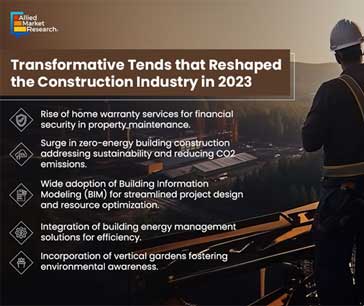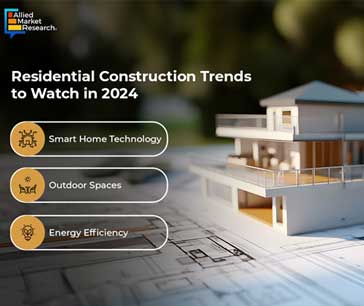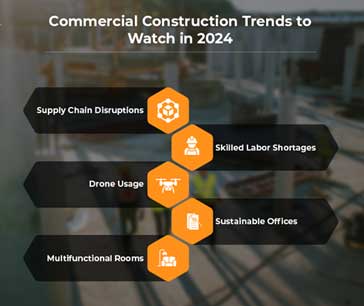Table Of Contents
- 2023: A Year of Opportunities and Challenges
- The Imperative for Construction in 2024: The Shift to Sustainability and Efficiency
- Digitalization and Generative AI: Pivotal Moment in Transformation
- Economic Uncertainty: Navigating Varied Impacts Across Segments
- Cost Volatility: Strategic Approaches for 2024
- Workforce Challenges: Adapting to New Norms is the Key
- Trends and Anticipations for the Construction Industry in 2024
- Challenges and Risks: Cybersecurity and Supply Chain Resilience
- Residential Construction Trends to Watch in 2024
- Commercial Construction Trends to Watch in 2024
- Looking Ahead: Embracing Change, Strategic Partnerships, and Sustainability Planning
- How Big is the Construction Industry?
- AMR’s Verdict: Navigating Growth and Transformation in 2024

Sonia Mutreja

Pooja Parvatkar
Construction Industry in 2024: Navigating Challenges and Embracing Opportunities

As we stand at the threshold of 2024, the construction industry, a pivotal force in global economic development, is poised for significant transformation. Before delving into the anticipated trends of the upcoming year, it is crucial to reflect on the impactful events that shaped the construction landscape in 2023. In a proactive move, Allied Market Research has taken the initiative to furnish a comprehensive brief on the construction industry for 2024. This initiative is designed to provide valuable insights to stakeholders, industry professionals, and businesses, offering a nuanced understanding of the evolving landscape. By anticipating the challenges and opportunities on the horizon, this brief aims to empower professionals in the construction sector to navigate the impending changes with foresight and strategic acumen.
2023: A Year of Opportunities and Challenges
In 2023, the construction sector experienced a surge in investments, strategic partnerships, events, innovations, and developments, positioning itself as one of the most dynamic and lucrative industries globally. From groundbreaking conferences sparking innovation to exhibitions showcasing cutting-edge technologies, the industry thrived amidst opportunities for growth and transformation.

Technological advancements and shifting customer preferences played pivotal roles in molding the sector. There have been transformative trends that reshaped the construction industry in the previous year.
On the flip side, the year was not without its challenges for the construction sector. Inflation emerged as a formidable adversary, triggering price hikes in raw materials and reshaping the industry's cost dynamics. Concurrently, labor shortages, compounded by a persistent skilled labor deficit, complicated project timelines and escalated costs of end-products. Economic uncertainties, characterized by rising interest rates and tightened lending standards, demanded a delicate balance between growth and risk for construction firms.
The Imperative for Construction in 2024: The Shift to Sustainability and Efficiency
As we transition into 2024, sustainability will continue to take center stage as a non-negotiable business imperative for the construction industry. Propelled by market trends, environmental regulations, and heightened customer expectations, the sector is making significant strides towards aligning with the International Energy Agency's Net Zero Emissions by 2050 Scenario.
Strategies include reducing embodied carbon, adopting passive design principles, and deploying energy-efficient equipment. Legislative acts, such as the Federal Buy Clean Initiative in the U.S., are expected to further propel the industry towards sustainable practices, signaling a shift towards greener and more environmentally responsible construction methods.
Digitalization and Generative AI: Pivotal Moment in Transformation
In 2024, the industry is poised for substantial growth, driven by the widespread adoption of Construction 4.0, IoT, and generative AI. Digitalization, a gradual process for the construction industry, reaches a pivotal moment in 2024 with the ascent of generative AI. This subset of artificial intelligence promises to revolutionize project design, schedule optimization, cost controls, safety, compliance, and quality assurance. The industry is actively exploring the potential of generative AI, alongside other transformative technologies like drones, autonomous guided vehicles, and robotics, to enhance efficiency and foster innovation.
These advancements facilitate real-time data monitoring, resulting in reduced service costs. Projections indicate that the global construction 4.0 market is anticipated to reach $62.2 billion, exhibiting a remarkable CAGR of 17.7% from 2022 to 2031.
Economic Uncertainty: Navigating Varied Impacts Across Segments
Economic uncertainty remains a challenge in 2024, with rising interest rates and high inflation casting a shadow over the construction industry. Market segmentation trends observed in 2023 are anticipated to persist, with nonresidential construction maintaining steady growth. Noteworthy federal investments in chip fabrication plants, biotechnology facilities, EV battery factories, and clean energy projects are expected to be catalysts for growth in this segment.
Conversely, the residential segment faces challenges tied to economic cycles, interest rates, and housing affordability. The industry must adeptly navigate these varied impacts, strategizing for resilience and sustainability across market segments.
Cost Volatility: Strategic Approaches for 2024
Cost volatility, stemming from fluctuations in labor costs and material prices, remains a top concern for construction firms in 2024. Operational strategies to mitigate cost increases include fixed payment terms, supply chain optimizations, disciplined cost/overhead management, and early customer engagement in the project life cycle. Prefab and modular construction methods gain prominence as effective tools to control material costs, reduce labor expenses, and shorten project schedules.
Workforce Challenges: Adapting to New Norms is the Key
The construction industry continues to grapple with persistent workforce challenges, notably a labor gap and difficulties in filling open positions. In August 2023, the industry revealed a staggering 350,000 job openings in construction, underscoring the urgency for strategic workforce planning.
The rise of remote work and career flexibility has compounded retention issues, prompting a shift in focus from talent retention to bridging the talent gap. Strategies to address this include embracing the gig economy, implementing upskilling programs, prioritizing worker safety, offering competitive compensation, and fostering diversity, equity, and inclusion.
Trends and Anticipations for the Construction Industry in 2024
The construction sector is at a crossroads as 2024 approaches, set for a transformative journey highlighted by unparalleled technology developments, sustainability imperatives, and a shift towards digitalization. Traditionally perceived as slow to embrace change, the construction industry now recognizes the critical importance of innovation for its expansion, effectiveness, and long-term viability. Let's explore the anticipated trends that will shape the construction landscape in 2024.
- Technological Advancements: The Rise of BIM A defining trend in 2024 is the increased utilization of Building Information Modeling (BIM). BIM is evolving from a tool for making 3D models to a comprehensive technique for managing information throughout the lifecycle of a construction project. This move promises better collaboration among architects, engineers, and builders, resulting in more cost-effective project management. According to forecasts, the global Building Information Modeling (BIM) in construction market is anticipated to attain $7,536.0 million by 2027, demonstrating a robust CAGR of 15.0% from 2020 to 2027. These figures underscore the benefits for businesses that extensively incorporate BIM, with notable enhancements observed in schedule and budget performance, error reduction, increased accuracy in project estimation, and improved waste management.
- AI and Machine Learning: Transforming Construction Processes Artificial Intelligence (AI) and Machine Learning (ML) are set to revolutionize construction processes in 2024. These technologies bring the ability to predict project outcomes, optimize scheduling, and efficiently manage resources. Safety is also enhanced through AI analysis of job site data to identify potential hazards. Pioneering companies like AirWorks, OpenSpace, Caidio, Procore Technologies, and Kwant.ai are leading the charge in integrating AI and ML into construction practices. As per estimations, the global artificial intelligence in construction market is projected to surpass $8.6 billion by 2031, growing at a CAGR of 34.1% from 2022 to 2031.
- Drones and Robotics: Shaping the Future of Construction Drones and robotics are poised to play an expanded role in the construction sector in 2024. Drones offer a swift and secure method for site inspection and monitoring, while robotics automate repetitive tasks like bricklaying and concrete pouring, enhancing efficiency and precision. The commercial rollout of brick-laying robots by FBR (formerly Fastbrick Robotics) in 2023 sets the stage for widespread adoption of these innovative technologies in 2024. Anticipated to hit $7,880.3 million by 2027, the construction robotics market is set to grow at a robust CAGR of 23.3% from 2020 to 2027. Concurrently, there is a notable surge in the adoption of automation across the construction industry, with numerous emerging technologies integrated into equipment to enhance construction processes. This trend has led to increased efficiency in construction activities. The recognition of automation's growth in the construction sector has spurred the establishment of several start-ups, introducing robotics as a transformative element in the construction market.
- Sustainability and Green Building: A Key Focus Sustainability takes center stage in 2024 as the construction industry actively implements practices to minimize negative environmental impact. This includes the use of renewable energy sources, waste minimization, and energy-efficient building designs. The industry is witnessing a surge in the number of buildings aiming for green certifications such as LEED (Leadership in Energy and Environmental Design), showcasing a commitment to sustainability that goes beyond regulatory requirements.
- Workforce and Labor Trends: Addressing Skilled Labor Shortages The construction industry faces a skilled labor shortage that is expected to persist until 2024. Companies are projected to increase funding for apprenticeship and training programs to bridge this gap. Upskilling employees to handle new technologies and sustainable building techniques will be a priority, with a significant percentage of American construction workers expressing a willingness to pursue additional training. Strategic partnerships with educational institutions may play a crucial role in providing customized training programs.
- Digital Transformation: Integrating Tools into Construction Activities Digital tools, including project management software and mobile applications, will become more integrated into daily construction activities in 2024. These tools facilitate improved communication, enhance data accuracy, and contribute to more effective project tracking. The rise of prefabrication and modular construction further underscores the industry's commitment to embracing innovative construction methods.
- Regulatory and Economic Factors: Navigating Change The construction industry must remain agile to comply with changing regulations, particularly those related to environmental protection and building safety standards. Additionally, economic uncertainties, such as fluctuating material costs and interest rates, require strategic planning in bidding processes and financial management to ensure competitiveness and profitability. The globalization of construction markets, with companies exploring international projects, adds a layer of complexity that demands understanding and adaptation to diverse regulatory environments and cultural nuances.
- Innovation in Construction Materials: Advancements for Durability and Sustainability In 2024, the construction sector anticipates employing cutting-edge building materials such as carbon fiber for increased strength and durability, aerogels for better insulation, and self-healing concrete that can patch up gaps. The emphasis on energy-efficient materials aligns with growing regulatory requirements and consumer preferences for sustainable construction practices.
Challenges and Risks: Cybersecurity and Supply Chain Resilience
As the construction industry becomes more digitized, cybersecurity concerns become paramount. Protecting sensitive project data and digital infrastructure from cyber threats will be crucial, necessitating investments in robust cybersecurity measures and employee training. Additionally, managing supply chain disruptions caused by global political unrest, pandemics, or natural disasters requires companies to develop more resilient supply chains, possibly through diversification or increased local sourcing.
Residential Construction Trends to Watch in 2024
The shift in priorities brought about by the pandemic has underscored the significance of home comfort for many individuals. Consequently, market trends indicate a growing demand for personalized features in residential spaces. Simultaneously, the looming specter of climate change is influencing construction market dynamics globally.
To stay at the forefront of these developments, here are key trends shaping the residential building sector in 2024:

- Smart Home Technology: The surge in smart homes is evident, with increasing demand for clap-activated lights, programmable thermostats, and other smart appliances.
- Outdoor Spaces: Extended periods spent at home have inspired a desire to replicate natural environments. This translates into increased need for usable outdoor spaces, such as exterior living rooms and outdoor kitchens.
- Energy Efficiency: Growing sustainability concerns are prompting the construction industry to focus on creating environmentally friendly homes.
In addition to these trends, homeowners are drawing inspiration from various stylistic elements, including glossy or matte black accents on doors, windows, and furniture, a preference for "biophilic design" featuring organic materials, and a focus on maximizing sunlight and fresh air.
Commercial Construction Trends to Watch in 2024
Similar to the residential sector, the commercial construction sector is poised for growth according to market forecasts. The rise of hybrid working models has redefined the concept of offices, leading to notable trends in the construction sector:
- Supply Chain Disruptions: Shortages in materials like steel, wood, and lumber might result in increased material costs. Locking in prices early can prevent surges when projects commence.
- Skilled Labor Shortages: Recruitment challenges for skilled construction workers are causing delays. Proactive measures, such as scouting trade schools and colleges, can help meet labor supply requirements.
- Drone Usage: Automation, including the use of robots and drones, is transforming hazardous tasks in construction.
- Sustainable Offices: The construction of sustainable offices is a priority for companies, with increased requests for greenery and energy-saving measures.
- Multifunctional Rooms: Adapting to the rise of remote work, businesses are incorporating multifunctional rooms and open working spaces to maximize available space.
Looking Ahead: Embracing Change, Strategic Partnerships, and Sustainability Planning
In 2024, the construction sector is set to welcome innovation and change. Companies that embrace new technologies and foster an innovative workplace environment will prosper. Strategic partnerships, whether with tech companies for digital solutions or educational institutions for workforce development, will become increasingly important, providing a competitive edge in a rapidly evolving industry. Long-term sustainability planning, encompassing social responsibility and environmental care, will be a key focus, ensuring the industry's contribution to a more sustainable and efficient future.
How Big is the Construction Industry?
The construction industry ranks among the world's largest in terms of spending. In the United States, there were 10.2 million construction workers as of November 2019, constituting nearly 8% of the entire workforce. Factors such as increased infrastructure needs and housing demand are expected to drive tremendous growth in the year 2024.

AMR’s Verdict: Navigating Growth and Transformation in 2024
The construction industry in 2024 is poised to be more inventive, dynamic, and interconnected than ever before. While challenges persist, the opportunities for growth and transformation are abundant. Companies that navigate these changes effectively will not only contribute to the industry's evolution but also pave the way for a future characterized by sustainability, efficiency, and innovation in construction. As we step into this transformative era, the construction sector emerges not just as a builder of structures but as a pioneer of progress, shaping a world that is resilient, sustainable, and technologically advanced. Take charge of the future in construction. Contact our expert analysts at Allied Market Research to gain valuable insights into the dynamic landscape of the construction industry and strategize your business success in 2024.

